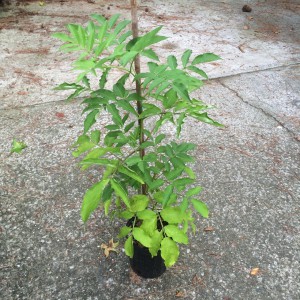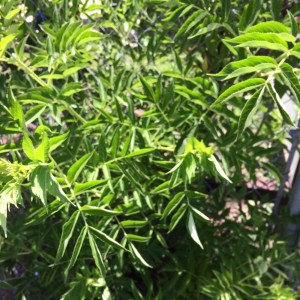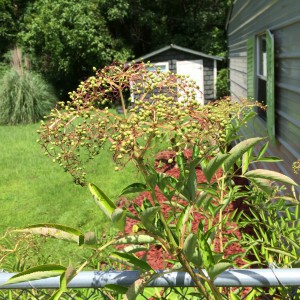An Elderberry plant in a container.
A mature Elderberry bush along a fence.
An Elderberry with unripe green berries.
Elderberry
(Sambucus canadensis)
The first thing I think of when I hear the word Elderberry is the song Elderberry Wine by Elton John. These plants have been mentioned in music and folklore for generations by many cultures from Newfoundland to the West Indies. In folklore, it is believed that evil spirits, witches and lightning can be warded off by planting an elderberry at the entrance to a garden or near a house. These accolades through the centuries are well deserved since these plants have so many uses. Their berries and flowers can be used in both medicinal and culinary applications plus their wood can be crafted into various items.
These large deciduous shrubs or small trees range in size from 6’ to 20’ tall with a spread of 5’ to 6’. They have opposite, pinnately compound leaves of 5 to 11 leaflets, and each finely serrated leaflet is 3 to 5 inches long, with the veins running to the tips of the serrations. In early summer, the elder tree bears finely branched, creamy-white, pleasantly scented, tiny flowers in flat-topped or slightly curved clusters (panicles) that are 3” to 10” in diameter. The glossy 1/8 inch purple-black berries ripen in mid-summer to early fall. The average mature (3 to 5 years old) plant yields 12 to 15 pounds of berries. The woody stems have smooth grey bark with intermittent corky bumps and the branches are filled with white pith that looks like Styrofoam.
The leaves, roots, bark, seeds and green berries are toxic due to containing glycosides that produce cyanide when digested. Only the ripe berries and flowers are edible. Be very careful when foraging for these plants in the wild since they have a couple of poisonous look-a-likes such as Water Hemlock and Hercules’-club. Always check with a local foraging or plant identification expert before eating wild plants.
The common elderberry has been prized for millennia for its many uses. The flowers can be battered and sautéed as fritters or added to pancakes to give them a light delicious flavor. Flowers can also be brewed into a healthful tea. Many people find the raw purple-black berries to be too tart to be appetizing, and since they can cause an upset stomach, they should be eaten sparingly. Once cooked, the berries make wonderful treats such as muffins and pies. The berries can also be made into syrups, juices, jellies, jams, dyes, and, of course, wine.
The pithy centers of the stems of the elderberry can be hallowed out to make flutes, whistles, straws and stiles for harvesting maple syrup. The wood must be dried and cured first otherwise it will still be toxic.
The flowers and berries have been used medicinally for a myriad of ailments since the time of the early Native Americans. They are high in antioxidants as well as excellent sources of vitamins A, B, and C. Syrup made from the berries can be used as a remedy for colds, flus, bronchial infections, asthma, and coughs. Elderberry infusions have a diaphoretic effect and are good for cooling a fever. Elder flower infusions when applied externally can heal rashes, swelling, burns, sunburns, and other skin inflammations such as eczema. Elderberries can be used as immunity boosters for the elderly and the immuno-impaired. There is now credible scientific research that proves the elderberry’s antiviral disease fighting properties. Studies show that elderberry syrup shortens the duration and severity of viral infections. Also, elderberries made into a wine or syrup mixed into a wine can help relieve neuralgia and arthritis. Thus, it is no wonder that the elderberry has been called “the people’s medicine chest.”
Recently, as my family and I were riding in the car, I was pointing out the many elderberry bushes that are in full bloom along the roadside in late June and early July. Elderberries can be found in the wild areas along the roadsides near creeks or low moist areas. So, plant your elderberries in a sunny to partial shade, well-drained moist location no more than 6’ apart. These shrubs have a shallow fibrous root system so they are sensitive to drought and deep cultivation. Elderberries are very cold hardy and live in Zones 3 to 11. They prefer a pH of 5.5 to 6.5 but will tolerate most soils as long as the soil doesn’t get too dry. Since they are only partially self-fertile it is beneficial to grow two or more cultivars to ensure cross-pollination, as this will give you a much better fruit set.
Ammonium nitrate is used for fertilizing elderberries in a commercial setting, but for homeowners it is safer to use 10-10-10 NPK and compost. In early spring, apply ½ pound of 10-10-10 fertilizer for each year of the plant’s age. Shrubs that are 8 years or older, give them no more than 4 pounds of 10-10-10 fertilizer per year.
Pruning is necessary because these shrubs are so fast growing and can become rangy. The most important reason to prune is to increase berry production. Two-year-old canes with lateral branches are the most productive and canes become less fruitful after about their third year. So, it is helpful to prune out older trunks, dead or weak canes during dormancy.
Elderberries are rarely hindered by pests and diseases. However, birds can be a problem, so use bird netting and scare devices such as plastic owls close to harvest time. Some diseases such as tomato ring spot, mildew, and stem cankers can affect these plants, but can be prevented by good sanitation of old affected leaves and weed control. Unfortunately, there are no insecticides listed for elderberries.
When harvesting the ripe berries, you can simply comb your fingers through the berry clusters to knock the berries off into a container; however, there is an easier method that will save the time of plucking out the stems and branches later. The trick is to cut off full clusters of berries and freeze them. Once frozen, you can give the clusters a good shake and only the berries will fall off. Be careful to pick out any green berries since they are toxic. Other than the aforementioned preparations such as pies, jams, jellies, and wines, your harvest can be preserved by drying the berries which mellows their flavor. The syrup or the whole berries can also be frozen to preserve your harvest.
There a number of recommended varieties such as ‘Adam’s #1’, ‘Adam’s #2’, ‘John’s’, ‘York’, ‘Nova’, ‘Scotia’, ‘Sutherland Gold’ (a yellow-leafed ornamental) and ‘Black Lace’ ( a black-leafed ornamental by Proven Winners).
References and External Links:
- The Berry Companion L. Bowling, Timber Press, 2000
- Identifying and Harvesting Edible and Medicinal Plants Brill, Harper, 1994
- The New Herb Bible by E. Mindell, PhD, Fireside, 2000
- “Eat The Weeds and Other Things, Too.” Green Deane, LLC. www.eattheweeds.com



